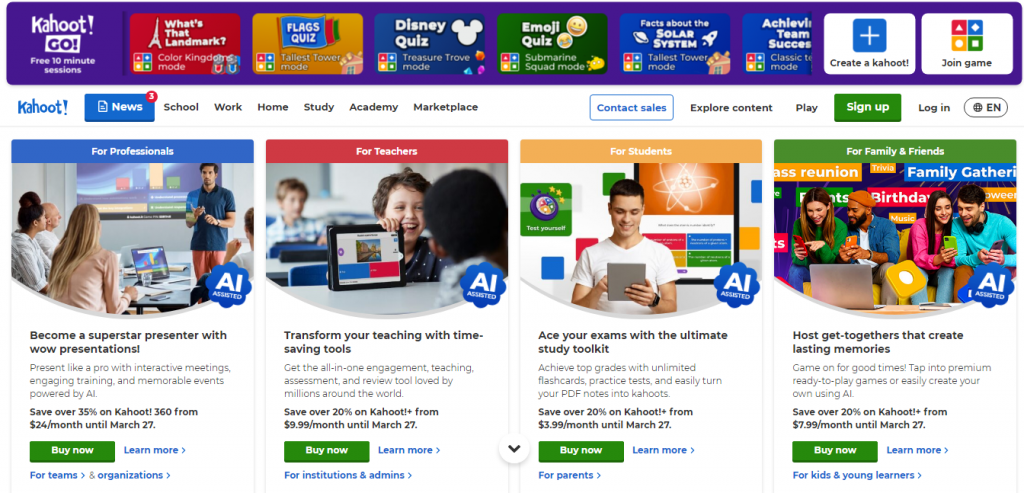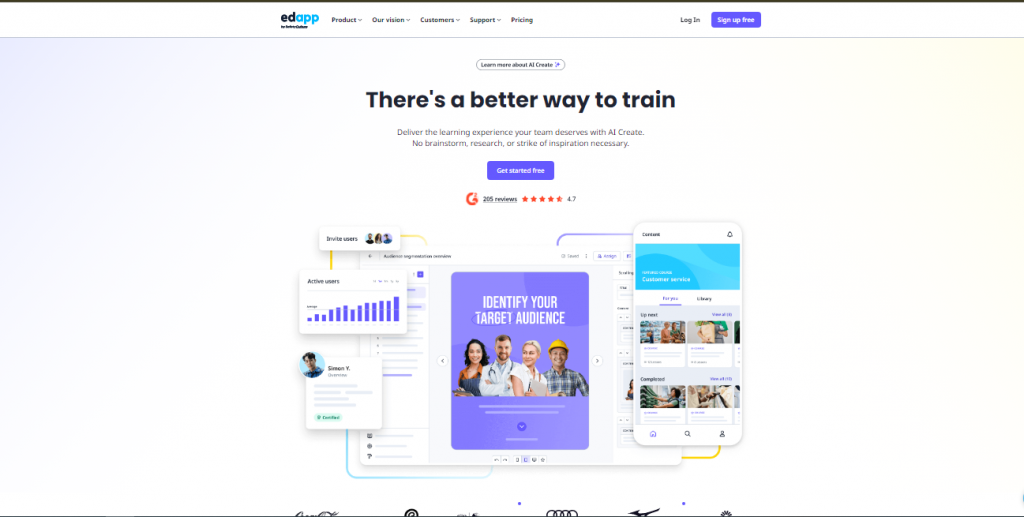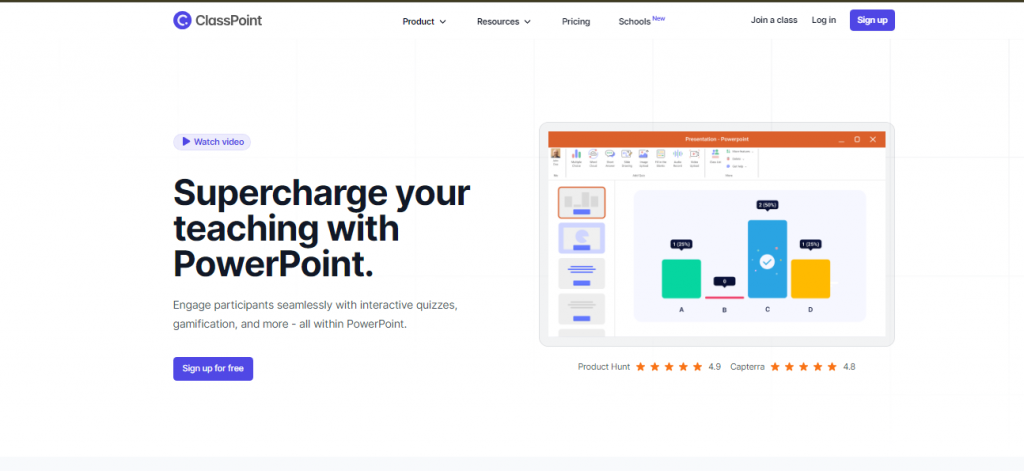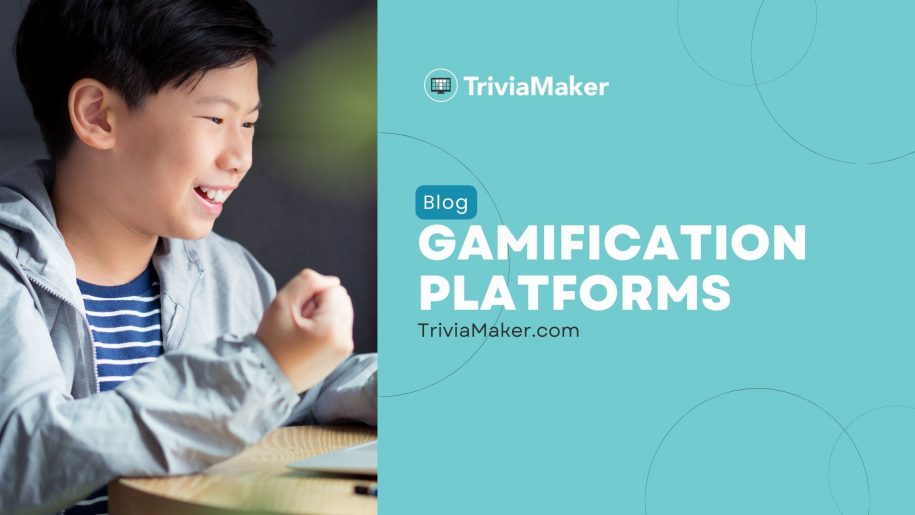Gamification refers to the inclusion of game elements, mechanics, and principles into non-gaming environments, ranging from educational programs to business processes.
1. Trivia Maker
TriviaMaker is a leading quiz creator platform that empowers users to craft and host engaging trivia games. TriviaMaker has gained popularity among teachers, leaders, and individuals worldwide for its user-friendly interface and versatile features.
TriviaMaker is the go-to gamification platform for making and hosting trivia games, offering an exciting and interactive way for educators, event organizers, and individuals to create memorable experiences. With a diverse range of applications, TriviaMaker enhances engagement in classrooms, events, and virtual gatherings.
Cost:
- Free Plan: Create unlimited quizzes, access basic features, and play pre-made games.
- Pro Plan (Starting at $6.99/month): Unlock advanced features like team play, image & video questions, and branded presentations.
- Enterprise Plans: Customize for large-scale events and organizations.
Key Features:
- Drag-and-drop question builder: Add multiple choice, true/false, open-ended, and more.
- Interactive formats: Choose from Jeopardy!, TicTac, List, Who Wants to be a Millionaire? styles.
- Real-time scoring & leaderboards: Keep everyone engaged and track progress.
- Multimedia support: Include images, videos, and audio for dynamic questions.
- Cloud-based & mobile-friendly: Create and play anywhere, anytime.
- Shareable & embeddable: Easily share your quiz online or offline.
TriviaMaker is available on multiple platforms, including Android, iOS, and Fire OS, making it accessible to a wide audience.
2. AhaSlides
AhaSlides helps you create engaging presentations with interactive elements like quizzes, polls, Q&A, word clouds, and more. Boost audience participation and gather valuable insights through real-time data.
Cost:
- Free Plan: Limited features, 7 live participants max.
- Essential Plan: $4.95/month (annual), 50 live participants, Q&A, quizzes, polls, word clouds.
- Plus Plan: $9.95/month (annual), 100 live participants, breakout rooms, integrations, data exporter.
- Pro Plan: $19.95/month (annual), 250 live participants, branding options, priority support.
- Enterprise Plan: Custom pricing, large events, advanced features.
Key Features:
- Interactive slides: Quizzes, polls, word clouds, Q&A, open-ended questions, spinner wheels, brainstorming, etc.
- Live presentation: Real-time results and data visualization.
- Collaboration: Co-edit presentations with team members.
- Audience Engagement: Participants join via a web browser or QR code.
- Data & analytics: Export results for further analysis.
- Templates & themes: Pre-designed templates to save time.
- Branding: Customize presentations with your logo and colors (paid plans).
Also, Read:
3. Quizlet
Quizlet offers a diverse range of AI-powered learning tools, including online flashcards, games, and expert-written solutions. With a focus on making studying engaging and efficient, Quizlet caters to various educational needs.
Cost:
- Free: Basic features, limited sets, ads.
- Plus ($7.99/month or $49.99/year): Ads-free, unlimited sets, custom study modes, diagrams, and progress tracking.
- Teacher ($39.99/month or $249.99/year): All Plus features, classroom tools, data insights, and priority support.
Key Features:
- Flashcards: Create and share flashcards with text, images, and audio.
- Study sets: Organize flashcards into sets for specific topics or subjects.
- Games: Match, Learn, Scatter, and Gravity games to reinforce learning in a fun way.
- Learn more: Test yourself with spaced repetition to optimize knowledge retention.
- Diagrams: Create and label interactive diagrams to visualize complex concepts.
- Tests and quizzes: Create custom tests to assess your understanding.
- Collaboration: Share study sets and collaborate with classmates or friends.
4. Kahoot

Kahoot is a widely recognized gamification platform renowned for its interactive quizzes and games that enhance learning experiences.
Cost:
Kahoot offers a range of pricing plans to accommodate different user needs:
- Free Plan: Basic features with limited customization options.
- Pro Plan: Starting at $10/month per user, offering advanced features such as branding, collaboration, and detailed reports.
- Premium Plan: Custom pricing, tailored solutions for larger organizations with enterprise-level needs
Features:
- Interactive Quizzes: Create and customize quizzes with multimedia elements like images and videos.
- Live Games: Host real-time interactive sessions where participants can join using a unique game PIN.
- Learning Games: Engage learners with gamified learning experiences, fostering active participation and knowledge retention.
- Collaboration Tools: Facilitate group activities and teamwork with features like team mode and shared challenges.
- Analytics Dashboard: Track performance metrics and assess learning outcomes through comprehensive analytics and reports.
- Integration Capabilities: Seamlessly integrate Kahoot with other platforms and tools, enhancing workflow efficiency and versatility.
5. EdApp

EdApp is a comprehensive gamification platform designed to enhance employee training and development.
Cost:
EdApp offers two pricing models:
- Subscription-Based Pricing: This model provides access to EdApp’s full suite of features for a monthly or annual fee.
- Custom Pricing: Tailored solutions are available for larger organizations with specific requirements, offering flexibility and scalability.
Key Features:
- Microlearning Modules: Break down training content into bite-sized modules for better retention and engagement.
- Gamified Learning Activities: Incorporate game mechanics such as points, badges, and leaderboards to motivate learners and enhance participation.
- Mobile Accessibility: Access training materials anytime, anywhere through EdApp’s mobile-friendly interface, ensuring flexibility and convenience for learners.
- Analytics and Reporting: Track learner progress and performance metrics to measure the effectiveness of training programs and identify areas for improvement.
- Customization Options: Personalize learning experiences with branded content, tailored courses, and customizable features to align with organizational objectives.
- Collaborative Learning: Foster collaboration and knowledge sharing among employees through interactive features like discussion forums and peer-to-peer feedback.
- Integration Capabilities: Seamlessly integrate EdApp with existing learning management systems (LMS) or third-party tools to streamline workflows and maximize efficiency.
6. ClassPoint

ClassPoint is a dynamic gamification platform designed to revolutionize the learning experience in classrooms and corporate training environments alike.
Cost:
ClassPoint offers flexible pricing options tailored to meet diverse user needs:
- Free Plan: Access basic features and limited functionalities.
- Premium Plan: Unlock advanced features and customization options for a competitive monthly or annual subscription fee.
- Enterprise Plan: Tailored solutions for larger organizations with specific requirements, offering scalability and comprehensive support.
Features:
- Gamified Presentations: Infuse presentations with interactive elements such as quizzes, polls, and challenges to captivate audiences and reinforce learning objectives.
- Real-Time Feedback: Provide instant feedback to participants, fostering a responsive and adaptive learning environment.
- Audience Engagement: Encourage active participation through gamified activities, ensuring learners remain focused and invested throughout the presentation.
- Analytics and Insights: Track learner progress and performance metrics to assess comprehension and identify areas for improvement.
- Customization Options: Tailor presentations to suit individual learning styles and organizational preferences, enhancing relevance and effectiveness.
- Seamless Integration: Integrate ClassPoint with existing presentation software and learning management systems for streamlined workflow and enhanced compatibility.
- Collaborative Learning: Foster collaboration and knowledge sharing among participants through interactive features and group activities, promoting a collaborative learning culture.
7. Mambo.IO
Mambo.IO is a gamification platform that helps businesses engage their employees and customers. It uses game mechanics, such as points, badges, and leaderboards, to motivate people to take desired actions.
Cost:
Mambo.IO offers a variety of pricing plans, starting at $5 per user per month. The cost of a plan will vary depending on the number of users and the features you need.
Features:
- Points and badges: Employees can earn points for completing tasks, achieving goals, and participating in company activities. They can then redeem these points for rewards, such as gift cards, time off, or donations to charity.
- Leaderboards: Leaderboards show employees how they are stacking up against their peers. This can help to create a sense of healthy competition and motivate employees to perform better.
- Challenges: Challenges are time-bound events that encourage employees to work together to achieve a common goal.
- Social recognition: Employees can give and receive recognition from their peers for their achievements.
- Gamified learning: Mambo.IO can be used to gamify training and development programs, making them more engaging and effective.
How to use gamification platforms for training?
Gamification injects fun and engagement into training, boosting knowledge retention and motivation. Here’s how to leverage it effectively:
Step 1: Define your goals & audience:
- What are your learning objectives? (e.g., increase sales, improve customer service)
- Who are you training? (new hires, managers, specific departments)
- Tailor your approach based on their preferences and learning styles.
Step 2: Choose your game mechanics:
- Points & Badges: Reward progress and achievements, motivating learners to strive further.
- Levels & Leaderboards: Create a sense of competition and encourage friendly rivalry.
- Challenges & Quests: Break down learning into smaller, engaging tasks, keeping them focused.
- Unlockables & Rewards: Offer incentives for completing tasks, like virtual gifts or real-world rewards.
- Storytelling & Avatars: Immerse learners in a narrative, allowing them to personalize their experience.
Step 3: Integrate with existing training:
- Don’t reinvent the wheel! Look for opportunities to add gamification elements to your current materials.
- Use interactive quizzes, simulations, and scenarios to test knowledge in a fun way.
- Turn lectures into engaging quests with challenges and rewards.
Step 4: Track progress & provide feedback:
- Use analytics to monitor learner engagement and identify areas for improvement.
- Celebrate achievements and milestones to boost morale and encourage further progress.
Remember:
- Keep it relevant & engaging: Align game mechanics with your learning objectives and target audience.
- Make it achievable: Set clear goals and challenges that are not overly difficult or frustrating.
- Offer variety: Mix up mechanics and activities to keep things fresh and interesting.
- Focus on learning, not just points: Ensure the fun elements support your overall training objectives.
Conclusion:
In 2025, gamification solutions are expanding beyond gaming to include education, business, and personal development. These tools offer benefits such as increased engagement, motivation, and improved performance.
Platforms like TriviaMaker and AhaSlides cater to various needs, while platforms like Quizlet and Memrise revolutionize language learning.
Businesses can use gamification for training through platforms like TalentLMS, Code of Talent, and Mambo. IO. To maintain engagement and support learning objectives, it’s crucial to define clear goals, tailor approaches to specific audiences, and integrate game mechanics seamlessly.

